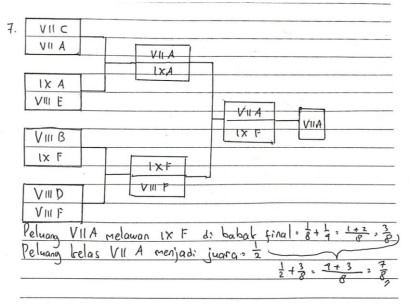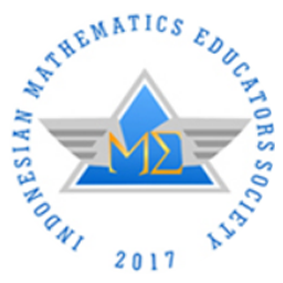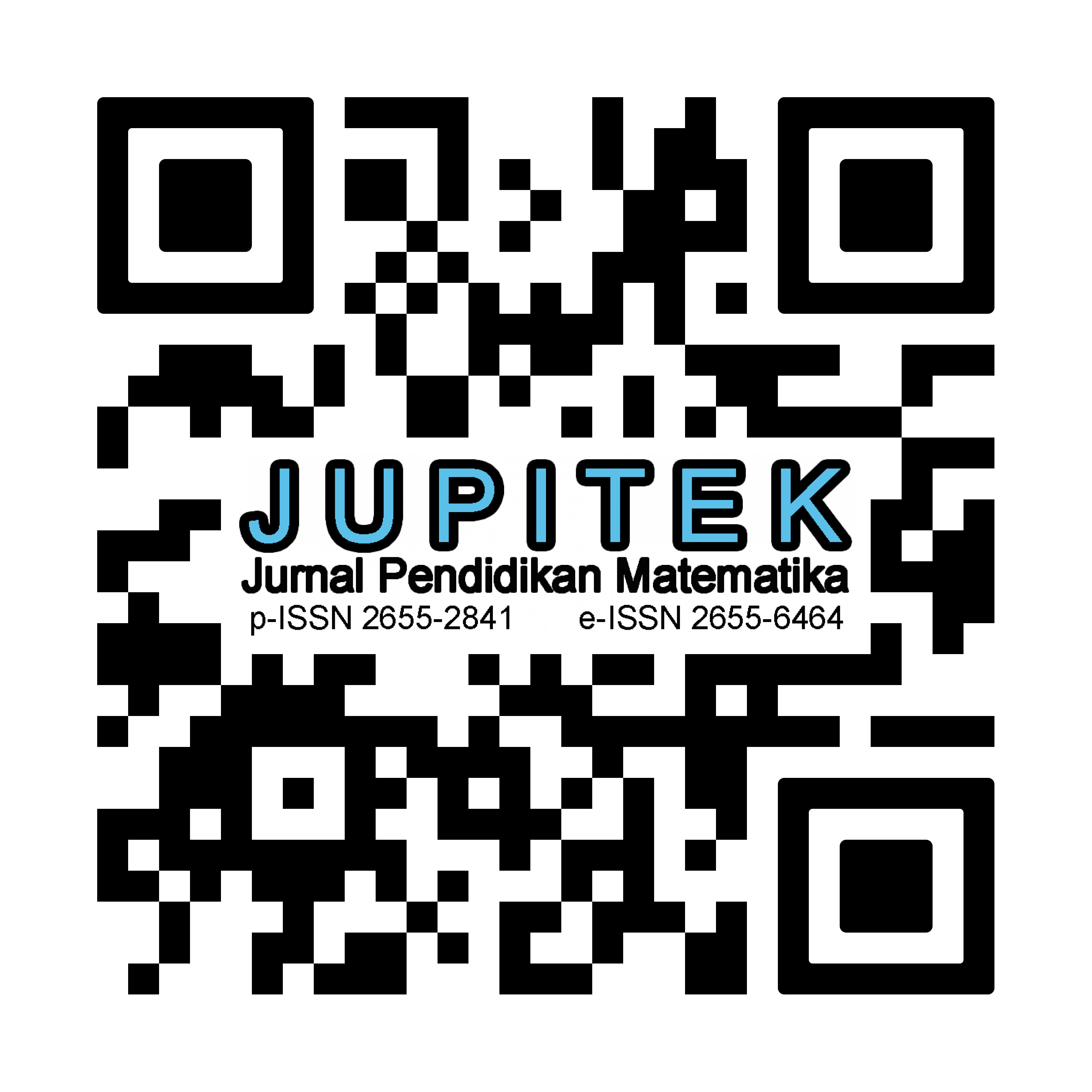STUDENTS’ ERROR ANALYSIS IN SOLVING PROBABILITY STORY QUESTIONS BASED ON REVISED NEWMAN THEOREM
Abstract
Generally, students still need help working on story-shaped questions. This error is natural, but if it continues, it will harm the mastery of the next material. The ability to solve story questions is closely related to numeracy skills, therefore knowing the location of the difficulties using the revised Newman theorem and the causal factors will help students achieve higher learning outcomes. This research was a quantitative descriptive approach, with the research subjects of junior high school students as many as 152 students. The instruments used were diagnostic tests and questionnaires. Each had an estimated reliability of 0.701 and 0.705 with good qualifications. The results show that students' most frequent types of errors in solving story questions on empirical and theoretical probabilities were 43% transformation errors, 36% comprehension errors, 15% process skill errors and encoding errors by 6%. The specific factors of student errors are not thorough students, being in a hurry, having difficulty understanding the questions, did not master the material, forgetting the formula, hesitating in determining the formula, not re-check the answers, and were unable to write the final project answers/conclusions. Interest and motivation factors as well as society factors are the general factors that most influence the mistakes made by students
Downloads
References
Ackland, A. (2014). More … or less ? Towards a critical pedagogy of Adult Numeracy. An International Journal. 9(2): 7–21.
Alhassora, N. S. A., Abu, M. S., & Abdullah, A. H. (2017). Newman error analysis on evaluating and creating thinking skills. India. 19(97): 413–427.
Arikunto, S. (2012). Dasar-dasar kependidikan Edisi 2 [Educational basics Edition 2]. Jakarta. Bumi Aksara.
Ashlock, R. B., Johnson, M. L., Wilson, J. W., & Jones, W. L. (1980). Guiding each child’s learning of mathematics: A diagnostic approach to instruction. Columbus. Bell & Howell Company.
Askury, A. (2009). Kesulitan belajar matematika permasalahan dan alternatif pemecahannya. matematika [Difficulty learning math problems and alternative solutions]. Matematika. 5(2).
Awofala, A. O. A. (2017). Effect of personalisation of instruction on students’ anxiety in mathematical word problems in Nigeria. Bulgarian Journal of Science and Education Policy. 11(1): 83–120.
Budiyono, B. (2008). Kesalahan mengerjakan soal cerita dalam pembelajaran matematika [Errors in doing story questions in learning mathematics]. Paedagogia. 11(1): 1–8.
Clements, M. A., & Ellerton, N. F. (1996). Mathematics education research: Past, present and future. Bangkok. UNESCO Principal Regional Office for Asia and the Pacific.
Decristan, J., Klieme, E., Kunter, M., Hochweber, J., Büttner, G., Fauth, B., Hondrich, A. L., Rieser, S., Hertel, S., & Hardy, I. (2015). Embedded formative assessment and classroom process quality: How do they interact in promoting science understanding? American Educational Research Journal. 52(6): 1133–1159.
Depdiknas. (2002). Pedoman usulan penelitian tindakan kelas [Classroom action research proposal guidelines]. Jakarta. Direktorat Pembinaan Penelitian dan Pengabdian pada Masyarakat.
Depdiknas. (2007). Pedoman pengembangan tes diagnostik mata pelajaran IPA SMP/MTs [Guidelines for developing diagnostic tests for science subjects for SMP/MTs]. Jakarta. Departemen Pendidikan Nasional.
Gasco, J., & Villarroel, J.-D. (2014). The motivation of secondary school students in mathematical word problem solving. Electronic Journal of Research in Educational Psychology.
Guilford, J. P. (1956). The Guilford-Zimmerman Aptitude Survey. Personnel & Guidance Journal.
HodnikČadež, T., & Škrbec, M. (2011). Understanding the concepts in probability of pre-school and early school children. Eurasia Journal of Mathematics, Science and Technology Education. 7(4): 263–279.
Jha, S. K. (2012). Mathematics performance of primary school students in Assam (India): An analysis using Newman Procedure. International Journal of Computer Applications in Engineering Sciences. 2(1): 17–21.
Kemendikbud. (2019). Laporan hasil Ujian Nasional. Pusat Penilaian Pendidikan Kementrian Pendidikan dan Kebudayaan [Report on the results of the National Examination. Center for Educational Assessment of the Ministry of Educational and Culture]. https://hasilun.puspendik.kemdikbud.go.id
Kemendikbud. (2020). Desain pengembangan soal AKM [AKM question development design]. Badan Penelitian dan Pengembangan dan Perbukuan Kementrian Pendidikan dan Kebudayaan.
Khiyarunnisa, A. (2019). Konstruksi tes diagnostik untuk mengungkap kesalahan siswa dalam menyelesaikan soal matematika tingkat SMA [Construction of a diagnostic test to uncover student errors in solving high school math problems]. Universitas Negeri Yogyakarta.
Kikas, E., Mädamürk, K., & Palu, A. (2020). What role do comprehension‐oriented learning strategies have in solving math calculation and word problems at the end of middle school? British Journal of Educational Psychology. 90: 105–123.
Legutko, M. (2008). An analysis of students’ mathematical errors in the teaching-research process. Handbook for Mathematics Teaching: Teacher Experiment. A Tool for Research,. pp. 141–152.
Magno, C., & Lizada, G. S. (2015). Features of classroom formative assessment. Educational Measurement and Evaluation Review. 6: 23-31.
Mubair, A. (2011). Permasalahan belajar dan inovasi pembelajaran: Panduan untuk guru, konselor, psikolog, orang tua dan tenaga kependidikan [Learning problems and learning innovations: A guide for teachers, conselors, psychologists, parents and education personnel]. Bandung: PT Refika Aditama.
Naresh, N., Harper, S. R., Keiser, J. M., & Krumpe, N. (2014). Probability explorations in a multicultural context. The Mathematics Teacher. 108(3): 184–192.
Raharjo, M., Ekawati, E., & Rudianto, Y. (2009). Pembelajaran soal cerita di SD [Learning story questions in Elementary School]. Yogyakarta. PPPPTK Matematika.
Raharjo, M., & Waluyati, A. (2011). Modul matematika SD program BERMUTU: Pembelajaran soal cerita operasi hitung campuran di sekolah dasar [Elementary mathematics module BERMUTU program: Learning about mixed arithmetic operations story questions in Elementary School]. Yogyakarta. PPPPTK Matematika.
Satori, D., & Komariah, A. (2014). Metodologi penelitian pendidikan [Educational research methodology]. Jakarta. Bumi Aksara.
Stoica, A. (2015). Using math projects in teaching and learning. Procedia-Social and Behavioral Sciences. 180: 702–708.
Templin, J., & Henson, R. A. (2010). Diagnostic measurement: Theory, methods, and applications. New York. Guilford Press.
Widoyoko, E. P. (2009). Evaluasi program pembelajaran [Evaluation of learning programs]. Yogyakarta: Pustaka Pelajar. pp. 238.
Wijaya, A., van den Heuvel-Panhuizen, M., Doorman, M., & Robitzsch, A. (2014). Difficulties in solving context-based PISA mathematics tasks: An analysis of students’ errors. The Mathematics Enthusiast. 11(3): 555–584.

Copyright (c) 2022 Dyah Nirmala Sani, R Rosnawati

This work is licensed under a Creative Commons Attribution-NonCommercial-ShareAlike 4.0 International License.
License and Copyright Agreement
By submitting a manuscript to Jurnal Pendidikan Matematika (JUPITEK), the author(s) certify and agree to the following terms:
- Originality and Authority: The submitting author is authorized by all co-authors to enter into this agreement. The manuscript describes original work that has not been published previously in a peer-reviewed journal, nor is it under consideration for publication elsewhere.
- Approval: Its publication has been approved by all author(s) and by the responsible authorities of the institutions where the work was carried out.
- Rights: The authors secure the right to reproduce any material that has already been published or copyrighted elsewhere.
- Licensing and Copyright: Authors retain the copyright to their work.
- License Grant: The authors grant Jurnal Pendidikan Matematika (JUPITEK) the right of first publication, with the work simultaneously licensed under the Creative Commons Attribution-NonCommercial-ShareAlike 4.0 International (CC BY-NC-SA 4.0).
- Self-Archiving: Authors are permitted and encouraged to deposit the published version of their article in institutional repositories, on their personal websites, and other academic platforms, with proper acknowledgment of its initial publication in Jurnal Pendidikan Matematika (JUPITEK).





.png)


